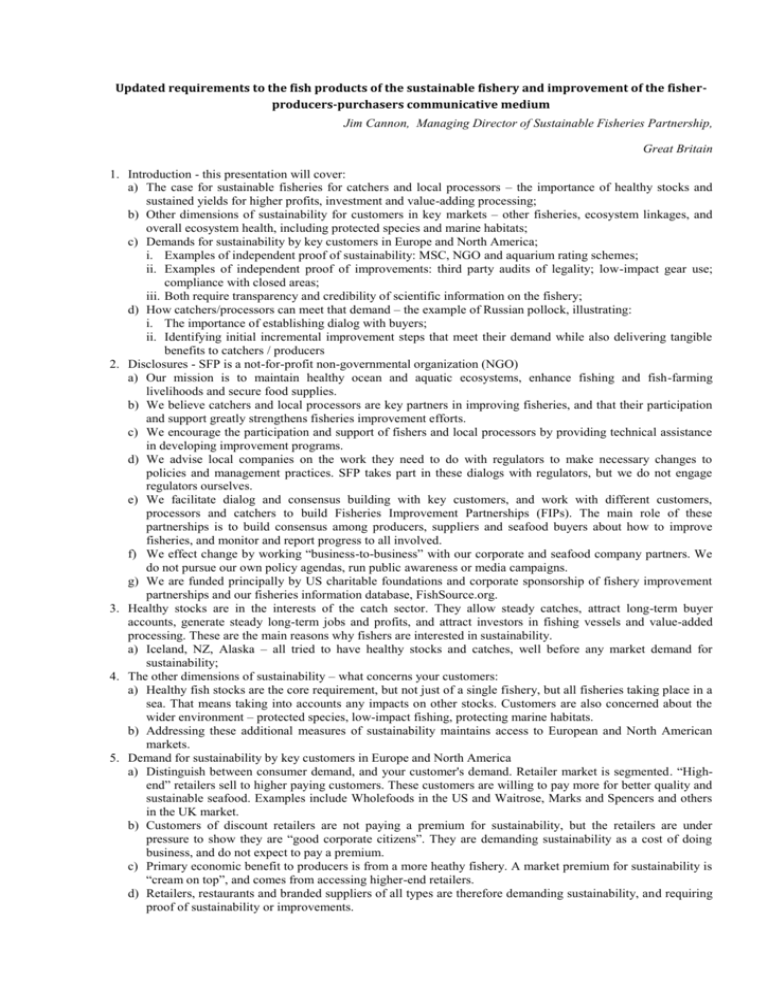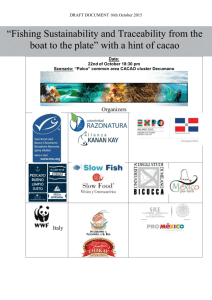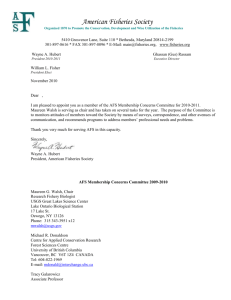Updated requirements to the fish products of the sustainable
advertisement

Updated requirements to the fish products of the sustainable fishery and improvement of the fisherproducers-purchasers communicative medium Jim Cannon, Managing Director of Sustainable Fisheries Partnership, Great Britain 1. Introduction - this presentation will cover: a) The case for sustainable fisheries for catchers and local processors – the importance of healthy stocks and sustained yields for higher profits, investment and value-adding processing; b) Other dimensions of sustainability for customers in key markets – other fisheries, ecosystem linkages, and overall ecosystem health, including protected species and marine habitats; c) Demands for sustainability by key customers in Europe and North America; i. Examples of independent proof of sustainability: MSC, NGO and aquarium rating schemes; ii. Examples of independent proof of improvements: third party audits of legality; low-impact gear use; compliance with closed areas; iii. Both require transparency and credibility of scientific information on the fishery; d) How catchers/processors can meet that demand – the example of Russian pollock, illustrating: i. The importance of establishing dialog with buyers; ii. Identifying initial incremental improvement steps that meet their demand while also delivering tangible benefits to catchers / producers 2. Disclosures - SFP is a not-for-profit non-governmental organization (NGO) a) Our mission is to maintain healthy ocean and aquatic ecosystems, enhance fishing and fish-farming livelihoods and secure food supplies. b) We believe catchers and local processors are key partners in improving fisheries, and that their participation and support greatly strengthens fisheries improvement efforts. c) We encourage the participation and support of fishers and local processors by providing technical assistance in developing improvement programs. d) We advise local companies on the work they need to do with regulators to make necessary changes to policies and management practices. SFP takes part in these dialogs with regulators, but we do not engage regulators ourselves. e) We facilitate dialog and consensus building with key customers, and work with different customers, processors and catchers to build Fisheries Improvement Partnerships (FIPs). The main role of these partnerships is to build consensus among producers, suppliers and seafood buyers about how to improve fisheries, and monitor and report progress to all involved. f) We effect change by working “business-to-business” with our corporate and seafood company partners. We do not pursue our own policy agendas, run public awareness or media campaigns. g) We are funded principally by US charitable foundations and corporate sponsorship of fishery improvement partnerships and our fisheries information database, FishSource.org. 3. Healthy stocks are in the interests of the catch sector. They allow steady catches, attract long-term buyer accounts, generate steady long-term jobs and profits, and attract investors in fishing vessels and value-added processing. These are the main reasons why fishers are interested in sustainability. a) Iceland, NZ, Alaska – all tried to have healthy stocks and catches, well before any market demand for sustainability; 4. The other dimensions of sustainability – what concerns your customers: a) Healthy fish stocks are the core requirement, but not just of a single fishery, but all fisheries taking place in a sea. That means taking into accounts any impacts on other stocks. Customers are also concerned about the wider environment – protected species, low-impact fishing, protecting marine habitats. b) Addressing these additional measures of sustainability maintains access to European and North American markets. 5. Demand for sustainability by key customers in Europe and North America a) Distinguish between consumer demand, and your customer's demand. Retailer market is segmented. “Highend” retailers sell to higher paying customers. These customers are willing to pay more for better quality and sustainable seafood. Examples include Wholefoods in the US and Waitrose, Marks and Spencers and others in the UK market. b) Customers of discount retailers are not paying a premium for sustainability, but the retailers are under pressure to show they are “good corporate citizens”. They are demanding sustainability as a cost of doing business, and do not expect to pay a premium. c) Primary economic benefit to producers is from a more heathy fishery. A market premium for sustainability is “cream on top”, and comes from accessing higher-end retailers. d) Retailers, restaurants and branded suppliers of all types are therefore demanding sustainability, and requiring proof of sustainability or improvements. 6. 7. 8. 9. i. Independent third party proof of sustainability – eco-labels and other schemes. Eco-labels - the Marine Stewardship Council is the leading example, demanded, for instance, in the US (e.g., Wal-Mart, Wholefoods), UK (the highest number of MSC labeled products of any country) and Germany (which consumes the greatest volume of MSC certified fish). Aquarium and NGO public ratings – the Monterey Bay Aquarium scheme is best known in the US, the Marine Conservation Society in the UK etc.. Monterey Bay Aquarium ratings are used in US food service (e.g., Compass Group, Aramark). Greenpeace retailer “league tables” in the UK, US etc. NGO advisors to customers – SFP to McDonald's, New England Aquarium to Royal Ahold US and Gorton's The new demand for fisheries improvements: a) Customers are increasingly understanding seafood sustainability cannot be achieved over-night, that incremental improvement steps are needed. However, they need information to make that case to their customers and critics. b) SFP is currently leading efforts to assist fisheries in developing comprehensive road maps to sustainability, and assisting catchers and producers in demonstrating progress to customers. This complements other steps catchers can take to demonstrate improvements: c) Examples of independent proof of improvements include: i. Third party audits of legality (in fisheries with perceived illegal fishing – e.g., Eastern Baltic cod); ii. Verification of use – through observer programs – of low-impact gears and fishing practices (for instance, in shrimp and tuna fisheries); iii. Verification – through VMS and observer programs – of compliance with closed areas (for instance, in bottom trawl fisheries worldwide, and pollock in Alaska). The demand for sustainability and fisheries improvements can only be met if a fishery has transparent and credible scientific information that is easily and publicly available. a) The full stock assessment report is the most important document to have publicly available. b) Credibility depends on an open scientific process, where full assessments and data are available and open to peer review. c) These two conditions are features of Russian competitors, such as the US, Canadian, Icelandic, New Zealand and European fisheries. How catchers/processors can meet that demand – the example of Russian pollock a) 2006: First informal meeting, Brussels seafood show in 2006 i. Participants included BAMR, Wal-Mart, McDonald's, Unilever (BirdsEye), Pacific Andes, Blue Ice, FRoSTA, Royal Greenland, The Fishin' Company, Delmar, WWF-US and MSC. ii. Recommendations include forming an association to represent catchers interests, and to seek MSC preassessment. iii. Russian producers subsequently met several times to discuss these and other issues, and formally announced the creation of the Pollock Catchers Association in August 2006. Further meetings and discussions around these recommendations and other domestic issues took place throughout the year. b) 2007: Second meeting, Brussels seafood show in 2007 i. NBAMR and Roliz provided an update on progress, noting efforts to reduce pollock roe recovery rate, split into an A and B season, by Pollock Catchers Association. ii. The Pollock Catchers Association had earlier announced that it had contracted a Certification Body to undertake an MSC pre-assessment of the fishery. iii. Participants also included Wal-Mart, McDonald's, BirdsEye, FRoSTA, Royal Greenland, The Fishin' Company, Delmar, FoodVest and the MSC. c) 2008: Third meeting, Brussels seafood show in 2008 i. Updates on progress with MSC pre-assessment, discussion of customer needs for verification of legality of catches. ii. Attendees included BirdsEye, Foodvest, Espersen, Delmar, The Fishin' Co, Royal Greenland, as well as representatives from Wal-Mart and Tesco's. d) BAMR-Roliz and SFP subsequently agreed to formally launch a Fisheries Improvement Partnership, to collaborate with the Pollock Catchers Association and aid communication and joint projects between producers and buyers in major markets. e) Lessons learned: i. Establish dialog between markets and producers. ii. Identifying and agree initial incremental improvement steps that meet customers' demands while also delivering tangible benefits to catchers / producers. Conclusion: a) Demand for sustainability from customers is growing, due to demand from consumers and pressure to be good corporate citizens. b) Customer understanding of fisheries sustainability is becoming more sophisticated. c) New demand for information demonstrating improvements in as-yet uncertified fisheries. d) Producers can maintain access to markets if they can meet that demand for information and demonstrate real fishery improvements in the water (e.g., increasing biomass, reductions in by-catch and illegal fishing etc.). e) Nonetheless, the largest and immediate benefits to producers will come from having a healthy fishery, with better catch rates, not flooding markets etc. – it is in a fishers own interests, regardless of market demand for sustainability.








